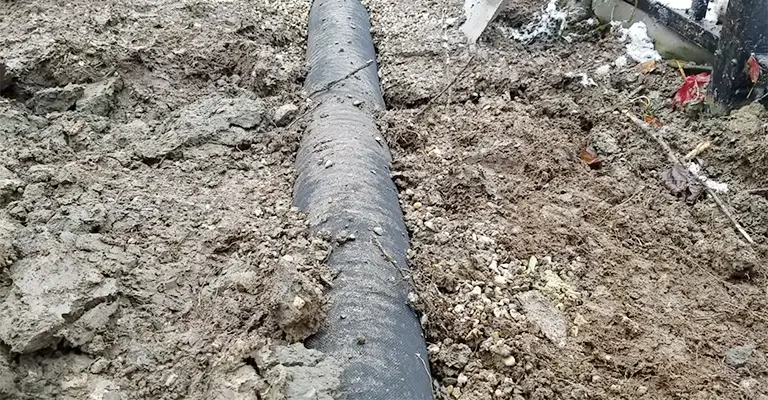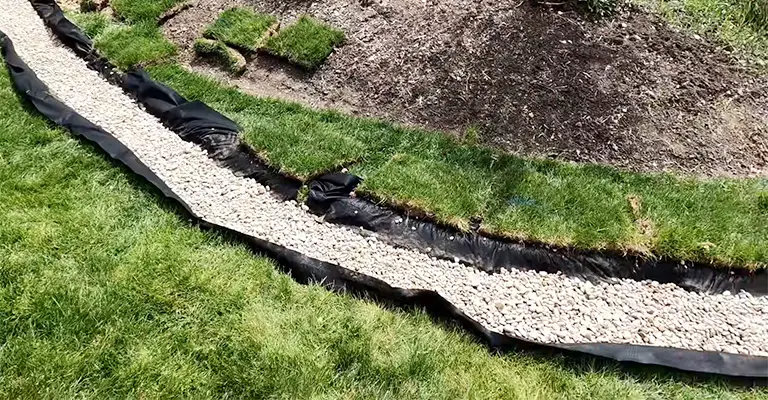A French drain consists of a perforated pipe surrounded by gravel or crushed stone, which allows water to enter and then directs it away from the property.
These drains have long been regarded as a highly effective solution for managing water accumulation and preventing water damage around homes and properties.
While it may seem straightforward, various factors can hinder the drain’s ability to efficiently remove water from the surrounding area. If you find that your French drain is not draining fast enough, it can be a cause for concern.
There are not always clogs within the pipes that are causing French drain drainage issues, so you should also check the ground around the system.
The weep holes can get clogged up when compacted soil and dense layers of sediment prevent water from reaching them.
It is also possible for French drains to fail in a variety of ways, such as clogging with debris or being insufficiently deep to trap water.
Let’s go over the common reasons why a French drain may not be draining fast enough, including blockages, improper installation, or inadequate slope.
Tips for Unclogging a French Drainage System

Cleaning the French drain regularly helps prevent dirt from clogging up the holes in the pipe.
The water cannot flow into and out of the drain pipe whenever the holes are blocked. Rather than draining from the yard, the blockage will cause water to back up.
Unclogging a French drainage system consists of following these steps:
Step 1
Identify the upper drain opening first. Find a hole on the ground surface where the drain begins to run.
As the drain works by assisting water in moving downward, look for it from the higher points of your yard if you aren’t sure where it begins.
Step 2
Run some water down the drain once you have located the beginning. Drainage can be flooded with water using a garden hose.
When you notice that water backs up instead of running through the drainage, it’s a sure sign that you have a clog. For the drain to function again, you need to remove the clog.
Step 3
You can unclog a French drain with a water-pressure washer. A high-pressure spray of water goes down the drain to clean the washer.
If the water reaches the clog, it may back up if you stand near the drain opening when sending water down it.
Ensure the water is aimed at the bottom section of the drainage system. In this way, getting rid of the clog will be easier. You should move the pressure washer around to clean the pipes on the sides.
Step 4
In case the clogs are incredibly stubborn, try using a plumber’s snake to clear them. A water pressure washer won’t dislodge a clog, so water will still back up from the drainage if it doesn’t work.
An engineer’s snake refers to a long piece of piping that is inserted into a blocked drain. The pipe stops moving further down the drainage when it reaches a clog. After it stops moving, push it gently into the clog.
In this manner, the clog will be loosened and broken up. Using a water pressure washer, you can break up the clog and push it down the drainage.
Clean the clog thoroughly with both a pressure washer and the plumber’s snake. Water will be able to freely drain down the drainage this way.
French Drain Cleaning Guide & Tips

Clogging can happen to French drains just like any other type of drain. When dirt and debris build up inside pipes, water eventually stops flowing. Following this guide will help you prevent water from backing up into your home.
Test The Drain
Whether you’re doing annual maintenance or planning a major replacement, many French drain experts recommend assessing the drain first. Testing how well the drain handles excess water can be done by flooding it.
To test your French drain, you must first locate the ground-level access point. Most commonly, this will be a grate sticking upward, the end of a gutter downspout, or a pipe.
After removing the cap or fitting, you can run a hose down the pipe. A hose can provide sufficient water volume to most systems in good condition. A clogged drain causes a backflow of water, and a blockage likely causes this.
Inspect The Ground Around The French Drain
There may be clogs inside the pipe that cause French drain issues, but the ground surrounding the system should also be checked.
Clogs above the pipes can be caused by compacted soil and thick sediment layers that prevent water from reaching the weep holes.
In addition, nearby trees can send roots under or over pipes, which can alter the pitch of the pipes, separate the connections, and cause other problems.
Roots growing near the surface, sinking, or heaving in the ground around the system may indicate what’s happening below.
Use A Heavy-Duty Drain Snake To Clear Stubborn Clogs
While pressure washing is light-duty and won’t damage your pipes, it often isn’t enough to solve stubborn clogs. There are some obstacles that a pressure washer cannot remove, including tree roots, compacted mud, and even small rocks.
A heavy-duty snake will help you remove those tough clogs. With powerful motors and a claw on the end of the steel cable, these machines can rip through anything in their path (though the process isn’t as fast as it sounds).
Usually available at tool rental locations, these machines can break through very hard clogs. Just tell the rental clerk how you intend to use the snake, and they will determine the most appropriate claw (or head).
Don’t Rush When Using A Snake
A snake can be a dangerous weapon if misused. Snakes are powerful tools, and they can be dangerous if mishandled.
As soon as the claw is removed from the pipe, it can flail around predictably and cause serious injury to the user. Make sure to wear leather gloves and eye protection when using a drain snake.
Because of these reasons, you shouldn’t use a drain snake quickly. A drain may feel like it can’t go any further after hitting an elbow fitting or obstruction.
Taking your time and allowing the snake to clear the clog or turn on its own, back it off and gently send it forward. It is likely that once the drain snake has passed through all obstructions, the drain will be clear.
Clean Out The Drain With A Pressure Washer
A pressure washer is the easiest and easiest way to clean a French drain. The handy tools come with onboard pumps for boosting standard water pressure and forcing it through a tiny orifice at the end of a wand.
This way, your pipes will not be damaged and should be done annually. This method is as simple as putting the nozzle into the pipe and blasting water at the clog. It is helpful to change the angle of the pipe if possible.
This method works well if the clog isn’t too solid, as it breaks it down until the water is able to clear it.
This procedure is most useful when spraying a clog near the end of the drain that has unobstructed access to the pipe. If you spray from behind the clog, the pipe may fill with water before clearing it.
Don’t Stand Over The Drain Opening While Cleaning
Regardless of whether you’re spraying into a hole in the ground or up a pipe, keep relatively clear of the drain end.
It is unlikely that a pressure washer can remove a solid clog immediately, so the water pressure will shoot down the pipe, hit the clog, and then ramp back up and out of the pipe.
In addition, the water isn’t coming out clean. To protect your eyes from splashes and sediment, stand on the pipe’s side and wear safety glasses.
Also, keep your hand away from the nozzle’s orifice, as the pressure at the end can cut your skin and damage your nerves.
Final Words
A French drain can be clogged for many reasons. Weep holes at the bottom of the pipe allow groundwater to flow freely so mud, sediment, and debris don’t get trapped.
Furthermore, plant and tree roots can find their way into pipes. There’s no point in ignoring the clog, no matter the cause. In your home, you may not be able to fully appreciate what a French drain does.
It is only recommended to install French drains on properties that are at risk of flooding. Water is collected and moved away from the basement walls so that it won’t penetrate the walls.
In that case, it may result in dampness, mold, structural damage, and other issues. In light of these factors, it is essential to maintain a French drain regularly.







